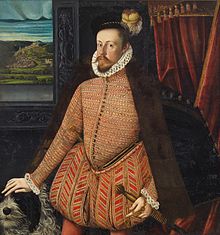Peascod belly
Appearance
(Redirected from Peascod)

A peascod belly is a type of exaggeratedly padded stomach that was very popular in men's dress in the late 16th and early 17th centuries. The term is thought to have come from "peacock,"[1] or from the form of contemporary plate armour.[2] Sometimes it was called a 'goose belly.'[3]
In the late 16th century the stomach of the doublet was padded to stick out,[4] however, by 1625, the padding had become more evenly distributed over the chest area.[5]
-
Archduke Ferdinand of Tyrol, 1542, by Jakob Seisenegger
-
Charles V Standing with His Dog, by Titian
References
[edit]- ^ Tortora, Phyllis G.; Eubank, Keith (2005). Survey of Historic Costume (4th ed.). New York: Fairchild. p. 175.
- ^ François Boucher; Yvonne Deslandres (1987). 20,000 Years of Fashion: the history of costume and personal adornment (Expanded ed.). New York: Harry N. Abrams. p. 228. ISBN 0-8109-1693-2.
- ^ Bradley, Carolyn G. (2001). Western world costume : an outline history (Dover ed.). Mineola, N.Y.: Dover Publications. p. 174. ISBN 9780486419862.
- ^ Harvey, Sara M. (2008). "The Seventeenth Century". In Condra, Jill (ed.). The Greenwood encyclopedia of clothing through world history. Westport, Conn. [u.a.]: Greenwood Press. p. 125. ISBN 9780313336645.
- ^ Harvey, Sara M. (2008). "The Northern Renaissance". In Condra, Jill (ed.). The Greenwood encyclopedia of clothing through world history. Westport, Conn. [u.a.]: Greenwood Press. p. 70. ISBN 9780313336645.



